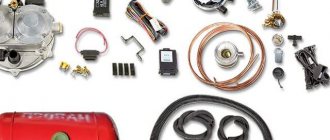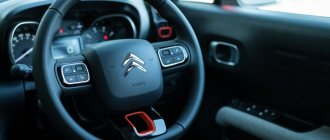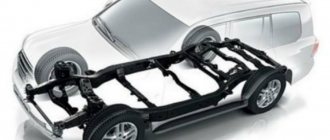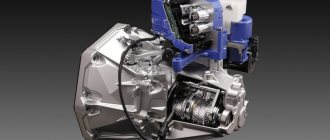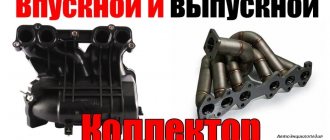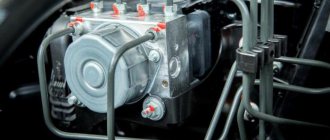Maximum traction is achieved by a wheel that keeps its tread contact patch at rest relative to the road surface. Both braking and acceleration of the car can cause slippage in this friction pair. The physical phenomena here are the same, the only difference is in the sign of the acceleration, it will be negative in the first case and positive in the second. But this does not affect the essence of what is happening, since both cases do not bring anything good.
ASR - what is it in a car and how does it work?
Such equipment is classified as active security systems. The main task of the system is to completely, or as far as possible, prevent the possibility of wheel slipping when driving on a winter road, as well as when driving on muddy country roads. It is slippage that often becomes the reason that the driver cannot leave on his own; he has to turn to the help of a tractor or drivers of passing cars.
There are two main principles of operation of the ASR traction control system:
- The first scenario starts if the car is moving at a speed of up to 60 km/h. In this case, a pump with brake fluid connected to the ASR sensors quickly creates pressure and brakes the wheel that has slipped.
- The second operation option is activated at speeds above 60 km/h. In this situation, braking can be dangerous, so ASR sends signals through the ECU to the engine and reduces torque. This is not always 100% effective, but it is very safe for the driver.
There is an opinion that the division into two scenarios occurred in order to preserve the pads, which can overheat and even burn out at high speed. But manufacturers say that at high speeds you simply cannot initiate braking from one side. This can lead to skidding and will only complicate the situation for the driver on difficult roads.
The system is controlled by sensors installed on each drive wheel. On vehicles with all-wheel drive, ASR equipment is much more expensive and more complex, but here it brings its own advantages to cross-country ability and safety of off-road driving.
Pros and cons of a car's traction control system
By preventing the drive wheels from slipping, the system gives the car, especially with a very powerful engine, several useful features:
- confident start from a standstill in the most efficient mode, when the wheels are constantly supported on the verge of failure;
- rapid acceleration, limited only by the coefficient of road adhesion, and not by the driver’s abilities;
- reduced tire wear on the drive wheels;
- increased safety when cornering under traction on a slippery road, the system prevents the car from turning into an uncontrolled skid;
- fuel is saved, which is not spent on the useless burning of tire rubber when slipping on dry asphalt;
- increased cross-country ability when the rotating wheel is not allowed to dig a hole under itself, where it remains until the tractor arrives, while the second wheel will receive additional torque, which will allow it to successfully pull out of a mud ambush.
There are also disadvantages that developers struggle with, not always successfully:
- wear of brake pads and discs increases;
- the car’s differential is overloaded, which is not always designed to transmit significant power to only one wheel;
- difficulties of compromise when choosing the threshold for the system to operate, beyond which it actively intervenes in control;
- difficulties in selective shutdown if the machine has a large set of additional functions for autonomous control of brakes and traction.
Recently, ASR is almost not used independently, but works with other electronic assistants, for example with the ESP stabilization system.
Is ASR better or worse than traditional ESP?
The designation problem is one of the devils of the modern automotive industry. Drivers of Toyota cars could read the first part of the publication with a grin, since they know that the traction control system is called TRC (Traction Control), and other motorists even found other designations in the documentation for their car - TCS (Traction Control System), ETS, ASC and other abbreviations. In general, these are designations of the same system.
ESP is more than just traction control equipment. This is a whole complex of means for maintaining directional stability, which includes the following equipment:
- ASR or any other type of traction control from the above named options;
- ABS is an anti-lock braking system that reduces the risk of wheel locking when braking a car;
- MSR is also anti-lock braking equipment that prevents the wheels from locking during engine braking;
- EBV is a system for distributing braking forces between all wheels of your car.
In luxury cars you can find a dozen more abbreviations that call security and control systems. So it is impossible to find the differences between ASR and ESP - these are the names of completely different phenomena in your car. ACP is only part of the ESP complex, providing one of the factors reducing the risk of skidding or burying in a mud and snow hole.
Why is ASR needed?
The abbreviation ASR is of German origin and is an abbreviation of the long German word “Antriebsschlupfregelung”, which literally means “slip control”. It refers to an electro-hydraulic system designed to prevent the wheels from losing traction with the road surface. ASR in its modern form was first used in 1979 on some BMW car models, and its very first version was tested in 1971 on American Buick cars. Now this traction control system is used by all the world's leading automobile manufacturers, who call it differently, for example, in Toyota cars its analogue is called TRC, in Opel - DSA, in Range Rover - ETC, in Honda - TSC, in Volvo - STC.
In fact, ARS is an “advanced” version of the ABS system: it not only fully performs all its functions, but also does not allow the car’s drive wheels to slip during intense acceleration and starting. Thus, when braking, ASR functions as an anti-lock braking system (ABS), and while driving it acts as a traction control system.
Are there clear benefits from an ASR system?
The advantages are that when going fishing on a dirt country road, you don’t have to get out of the car and push it, getting all your clothes dirty. As soon as the wheel begins to spin, the system comes into action and practically locks it, allowing the other drive wheel with better grip to pull the car out.
The ASR traction control system is practically not installed in inexpensive cars. Most often, this is a privilege for a car of a higher class or more expensive configuration. If you have a choice whether to install ASR in your car, but you need to pay extra money for it, you should choose the option of installing this complex. This increases your confidence and safety in operation. Even the first winter with your car will show that you made the absolutely right decision.
Electronic Stability Control (ESC/ESP)
Electronic stability control, or dynamic vehicle stability control, is a computer control system that not only controls each individual wheel brake, but is also capable of simultaneously reducing engine power while braking, which provides control over the vehicle's handling.
The vehicle stability control system was first used by Mercedes in the mid-90s. In 2012, the United States obliged all automakers selling cars in America to equip all vehicles entering the US market with a dynamic stabilization system. This has made it possible to significantly reduce accidents on the roads of the United States. According to the IIHS (Insurance Institute for Highway Safety), the introduction of electronic stability control in new vehicles may have prevented 30 percent of road accidents worldwide.
ESC/ESP technology consists of six important components: wheel speed sensors, a control module, a sensor that determines the angle of movement of the vehicle on the road, a yaw rate sensor, an accelerometer and a hydraulic modulator.
Please note that the hydraulic modulator used in the ESC system is exactly the same as in the ABS system. So as you can see, the ESC system is an improved ABS system, which has added a sensor that monitors the deviation of the vehicle’s course, an accelerometer, and a sensor that controls the angle of movement of the vehicle on the road. . To understand how the ESC/ESP system works, imagine that you are driving on a highway at a speed of 95 kilometers per hour.
Suddenly a dog or any other animal runs out onto the road. You, trying to avoid the impact, tilt the steering wheel to the side. What happens at this moment in a car equipped with a stability control system? The yaw rate sensor determines which trajectory the car is moving along.
To understand how the ESC/ESP system works, imagine that you are driving on a highway at a speed of 95 kilometers per hour. Suddenly a dog or any other animal runs out onto the road. You, trying to avoid the impact, tilt the steering wheel to the side. What happens at this moment in a car equipped with a stability control system? The yaw rate sensor determines which trajectory the vehicle is moving along.
The sensor that determines the angle of movement of the car transmits data to the system about the position of the front wheels. The accelerometer determines whether your vehicle is slipping, and speed sensors, just like in the ABS system, determine and control the rotation speed of each wheel.
If you twist the steering wheel very sharply to avoid an impact, your car will not immediately begin to shift in the direction the steering wheel is turning, but will continue to move straight for a short time. This effect occurs due to Newton's first law. The fact is that the front wheels, after you turn the steering wheel too sharply, will not have enough traction to maintain traction, which will ultimately lead to the front wheels sliding and the car will continue to move straight.
In this case, the exchange rate stability control (ESC) will come to the rescue. In such a situation, the control electronic unit will receive a discrepancy between the data received from the sensor measuring the angle of movement of the vehicle and the actual movement of the vehicle (which is transmitted by the yaw rate sensor).
As a result of this discrepancy, the system commands the hydraulic system to increase braking force to the rear left wheel or right wheel (depending on which way you turn the steering wheel). This allows you to avoid skidding due to sliding of the front wheels and level the car. If necessary, the system can also reduce engine power (lower speed) by sending a signal to the throttle.
If the car were not equipped with a dynamic stabilization system, then by sharply turning the steering wheel to the side, the front wheels would begin to slide, and the rear of the car would begin to skid to the side. So the ESC/ESP system controls the stability of the car on the road. To better understand how the vehicle's dynamic stabilization system works, watch the video below:
Turn on Russian subtitles
Here's a video of the cutting edge:
Another video that explains the principle of operation of the ESP system:
Are there any disadvantages to ASR equipment in your car?
Many experienced motorists will look at how the ASR system works, understand its primitiveness and say that it makes no sense. This is only partly true. If you are an experienced driver with 20 years of experience driving on difficult roads, then even without such help you are unlikely to get stuck in snow captivity. But for car owners with less vivid experience, such complexes will still be useful.
Among the disadvantages, it is worth highlighting only a few features:
- quite high cost if such a system can be installed on your car as an option when ordering a car in the showroom;
- not always effective response; very often the ASR initiates braking too late, when the car has already dug in;
- controversial work at high speeds, since here this equipment is powerless to do anything effective;
- the inability to disable on some cars that do not allow you to deactivate the entire ESP module;
- rapid wear of the pads if you constantly drive on rough or dirty roads with the risk of the wheels slipping.
ASR will not judge whether slipping is dangerous or safe on your car. It will work in any situation where the sensors indicate a slipping wheel. Of course, without turning off such a system, you will not be able to demonstrate the skills of sports driving, police turns and beautiful controlled skidding on the snow. The ASR will turn on at the most crucial moment and ruin your turn.
SRS System Maintenance
The SRS system does not require frequent maintenance, but it must undergo a full diagnostic once every ten years. After airbags deploy, they must be completely replaced because they are disposable. When operating the SRS system, you must ensure that its elements (especially sensors) do not heat above +90 °C.
It must also be remembered that the degree of effectiveness of this vehicle’s passive safety system largely depends on how correctly the driver and passengers are positioned in its interior. For seat belts and active head restraints to function properly, the seat backrests must be tilted no more than 25°. In addition, the seats should not be moved too close to the airbags.
Results: how can you evaluate the performance of ASR on a car?
It is difficult to give an unambiguous assessment of this set of security systems. As part of ESP, this unit copes well with certain nuances at low speeds. But when driving along the highway, ASR can even prevent the driver from correcting the situation on his own. The benefits of braking a wheel during slippage are also controversial.
Unfortunately, ASR is not a replacement for a good mechanical lock, as the electronics cannot distribute torque across all drive wheels as effectively. However, this is a solution for those cars in which there cannot be any blocking. If you have the choice of optionally installing such a system, then you should take advantage of this offer.
What is DSC on Mazda
The name DSC is an abbreviation for Dynamic Stability Control. In the official Russian manuals from Mazda, it is defined as an anti-skid system - and this name fully reflects the purpose of DSC in a car.
This system can be considered the result of the long-term development of ESP devices, which are the first exchange rate stability systems in the history of the automotive industry. And the tasks of the new generation of systems used on Mazda remain the same:
- protection against vehicle slippage;
- skid protection;
- preventing the machine from tipping over.
To carry out its functions, the DSC system uses a wide range of sensor indicators, which allows it to timely and accurately regulate the intensity of braking, as well as the traction transmitted to individual wheels.
As a result, on any road surface, including heavy ice, reliable grip and stability are ensured, starting and intense acceleration are simplified. It also prevents wheels from slipping if there is a coating underneath them with different characteristics.
Nuances worth knowing about
The effectiveness of the anti-lock braking system depends on the condition of the road. If you are driving on an uneven road surface with bumps and potholes, then the car’s braking distance will be much longer than usual. This is explained very simply. When a car slows down, its wheels “bounce” for a moment. This leads to loss of traction and, as a result, the cessation of rotation. ABS perceives this as a blockage and stops braking. When adhesion to the coating is restored, the system has to rebuild. This takes time - hence the increase in braking distance. To make the ABS work optimally in this situation, simply reducing the speed of the car will help.
It should be remembered that active safety systems help the driver in a difficult situation, and do not take control of the car, so the car enthusiast should not relax - he must be prepared for anything.
Maximum traction is achieved by a wheel that keeps its tread contact patch at rest relative to the road surface. Both braking and acceleration of the car can cause slippage in this friction pair. The physical phenomena here are the same, the only difference is in the sign of the acceleration, it will be negative in the first case and positive in the second. But this does not affect the essence of what is happening, since both cases do not bring anything good.
How does ESP work?
External sensors analyze various parameters - the functioning of the braking system, the characteristics of the vehicle's movement, the position of the accelerator, and changes in the steering angle. This data is transmitted to the control unit. He compares the information received with the actual movement of the car. If ESP decides that the driver has lost control of the car, it intervenes in the control, that is, it uses mechanisms that are associated with other active safety systems.
Correcting the trajectory of the machine is carried out in several ways:
- By braking specific wheels. The system itself decides which wheels will brake. So, when skidding, braking is carried out by the outer front wheel.
- Thanks to changes in engine speed.
The ESP control unit also interacts with the engine and automatic gearbox of the car. This allows the system to adjust their operation in force majeure circumstances.
What does ABS consist of and what is its operating principle?
The design of the system implies the presence of a control unit, speed control sensors and a hydraulic modulator.
The functioning of the anti-lock braking system involves three stages: releasing pressure in the brake system cylinder, maintaining it and increasing it to the required level. In reality it looks like this:
- When braking, speed sensors transmit data to the control unit.
- The control unit smoothly reduces the speed of the car.
If one of the wheels begins to slip or has completely stopped, the sensor informs the control unit about this, which activates the exhaust valve. It blocks fluid from entering the wheel brake cylinder - the pump immediately begins returning it to the hydraulic accumulator. The result is that the blocking is removed. When the wheel speed has returned to normal, the control unit closes the exhaust valve and opens the intake valve. As a result, the pump starts working again, but now it performs the actions “in the reverse order”: it pumps pressure into the brake cylinder, which allows the wheel to be braked. All these operations are carried out very quickly. They are repeated until the vehicle comes to a complete stop.
